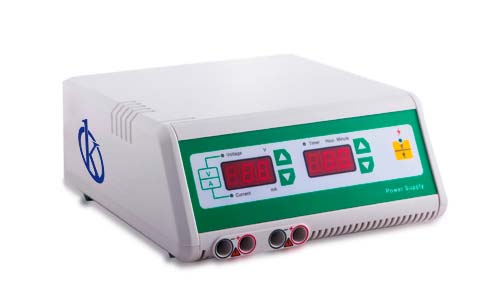A power supply for electrophoresis chambers is a device used to generate the electrical current that allows to feed the separations of DNA/RNA, PAGE electrophoresis and membrane transfer. Note that the voltage determines the extent of the function, for example, 300V is strong enough to make the gels work, while 250V is needed to make transfers. This equipment acts as a transformer, rectifier and regulator in its output, to avoid voltage spikes that damage the system.
Electrophoresis is a laboratory methodology that is based on the principle of migration of molecules through a gel or matrix of porous nature, when an electric field is applied, which allows separating these molecules according to their size or molecular weight, thanks to the action of a power source for electrophoresis cameras, because this device is responsible for providing the electric field that is needed to be able to move or mobilize the molecules.
Main characteristics of a power supply for electrophoresis cameras
Among the main characteristics of a power supply for electrophoresis cameras are those properties that refer to the capacity of the same. These features include:
- Voltage: It refers to the range of voltage that a source is able to provide, it is important to ensure that our source meets the voltage ranges for all our applications, because this range cannot be exceeded.
- Current: Specifies the current range that the power source can provide us. Like the voltage feature, this range cannot be exceeded.
- Power: This parameter indicates the maximum combination of voltage and current that the source can supply us. It is very important to verify this feature since there are dual-range or multi-range sources that are limited by their power, but allow different ranges of voltage and current.
How to handle a power supply for electrophoresis cameras?
First, the power supply for electrophoresis cameras is connected to the system camera, thus establishing an electric field between the two electrodes. Afterwards the DNA samples loaded into an agarose gel will move through the gel to the anode with the agarose gel matrix separating the DNA molecules by size.
Electrophoresis power supplies typically have a variable output voltage that allows the operator to set the output voltage for cameras of different sizes and modify the voltage for better results. The power source for electrophoresis is designed for continuous use in the separation of DNA, RNA and proteins. Therefore, failures in the power supply of the electrophoresis cameras can also cause failures in the results of the technique, which is why it is vital to ensure that the power supply is working properly.
What does Kalstein offer you?
Kalstein is a manufacturer of medical and laboratory equipment of the highest quality and the best technology at the best PRICES in the market, so you can make your PURCHASE confidently with us, knowing that you have the service and advice of a company specialized in the field and committed to provide you with safe, economical and effective options to perform your functions in the right way. HERE
This time we present our High Voltage Power Supply YR03407. This innovative equipment with cutting edge technology has the following features
- Touch keys, dual-core microprocessor or intelligent control;
- 0-9 digital button, makes operation simpler and more convenient;
- Enter the preset and the actual output value at the same time;
- Can store 100 electrophoresis methods;
- With auto memory function;
- With step-by-step control function (10 editable groups, each group of up to 10 automatic connection operation programs);
- With pause control function (including real-time tuning)
- With standard operation function, synchronization, V-hr, step by step;
- With constant voltage, constant current, constant power, malfunction, intelligent fault warning functions
- Automatic detection of no load, overload, short circuit, rapid resistance change, ground leakage and system overheating.
For more information we invite you to take a look at: HERE

